Chinese money plants have a unique look, but are easier to care for than you might think. In this post, I’ll show you all you need to know in order to be successful so you can enjoy it for years to come.
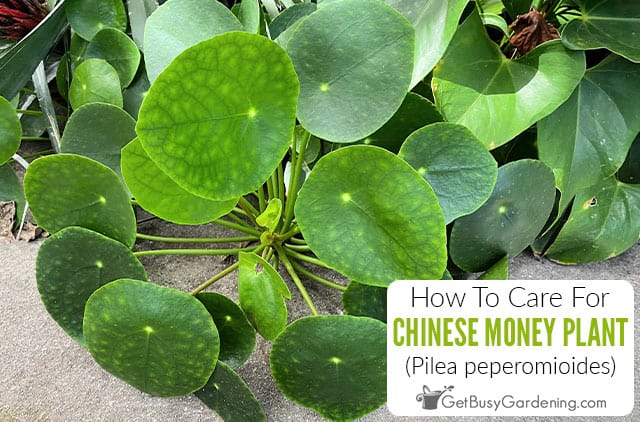
The unique foliage and easy-care nature of the Chinese money plant makes it an increasingly popular houseplant for beginners.
But once you have one, it’s important to understand how to care for them properly.
In this guide I’ve shared everything you need to know about Chinese money plant care.
From how much sun, water, and fertilizer they need to how to prune and propagate, it’s all included here.
Chinese Money Plant Quick Care Overview
| Scientific name: | Pilea peperomioides |
| Classification: | Tropical plant |
| Common names: | Coin Plant, Pancake Plant, Sharing Plant, UFO Plant |
| Hardiness: | Zones 10+ |
| Temperature: | 55-86°F |
| Flowers: | White or light green blooms in the spring |
| Light: | Full shade, bright indirect light indoors. |
| Water: | Allow soil to dry between waterings, do not overwater |
| Humidity: | Average to high |
| Fertilizer: | All purpose indoor plant food spring-fall |
| Soil: | Well-draining, aerated soil |
| Common pests: | Aphids, whiteflies, fungus gnats |
Information About Chinese Money Plant
The Chinese money plant (Pilea peperomioides) is a perennial, tropical evergreen native to southwestern China.
It has a brown central stem that produces delicate round waxy green leaves. The shape of the foliage is what earned it many nicknames, such as coin plant, pancake plant, and UFO plant.
It’s known for producing abundant offsets that are easy to propagate, which gives it another nickname: the sharing plant.
Once mature, it can reach heights around 18” tall. Many gardeners train the main stem to grow upright, otherwise it will naturally fall and become a trailing plant.
Other Plants Called “Money Plant”
Before we go on, I want to make sure that you and I are talking about the same plant. You see, there are a few others that go by the common name “money plant”, so it’s easy to get confused.
This article is about Chinese money plant (Pilea peperomioides) care. If this isn’t the plant you’re looking for, then maybe you’ll find it in the list below. Otherwise, keep reading.
- Money Tree (Pachira aquatica)
- Jade Plant (Crassula)
- Pothos Plant (Epipremnum aureum), aka Devil’s Ivy
Different Types Of Chinese Money Plant
The Chinese money plant was once hard to find. Its popularity has made it more widely available, and there are even a few variegated options.
But no matter which type you have, they can all be cared for in the same way.
- Pilea peperomioides ‘Mojito’ – The deep green leaves on this variety are mottled with a lighter, bright green.
- Pilea peperomioides ‘Sugar’ – The rounded leaves have wavy edges and a subtle white veining.
- Pilea peperomioides ‘White Splash’ – Small white speckles, almost like drops of paint, decorate the green leaves of this variety.
Flowers
Pilea peperomioides flowers are rare, especially indoors. Occasionally, mature plants that have been exposed to a period of cold can produce tiny blooms in the spring.
The blossom color can range from white to pale green, and grow from pink stems at the center of the plant.
Toxicity
The Chinese money plant is non-toxic to both pets and people, so you don’t have to worry about your cats and dogs. To find out more about houseplant toxicity, check out the ASPCA website.
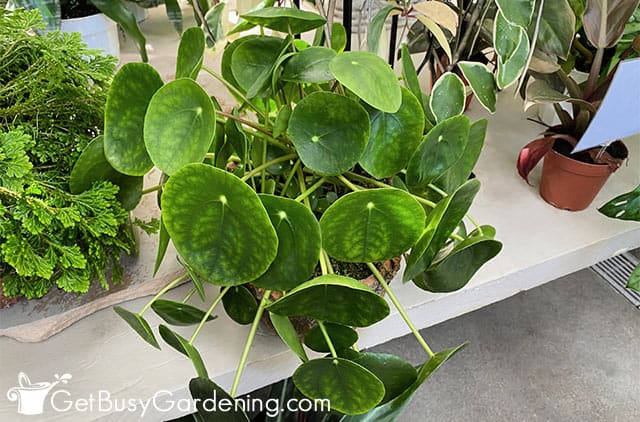
How To Grow Chinese Money Plant
Before we chat about how to provide the best Chinese money plant care, we need to discuss where to keep them. Choosing the right location is the first step in long-lasting health.
Hardiness
Pilea peperomioides are not hardy, and can only survive cold temperatures for a very short period of time.
They can only grow outdoors year-round down to zone 10. In climates that experience temps below freezing, you’ll need to overwinter them in a sheltered location or indoors as a houseplant.
Where To Grow
They can be grown in the ground in warm enough climates, but need well-draining soil and full shade.
But even outside, Chinese money plants are most popularly kept in containers.
It allows you to grow them anywhere that is shaded outdoors, or indoors in a spot with bright indirect or diffused light.
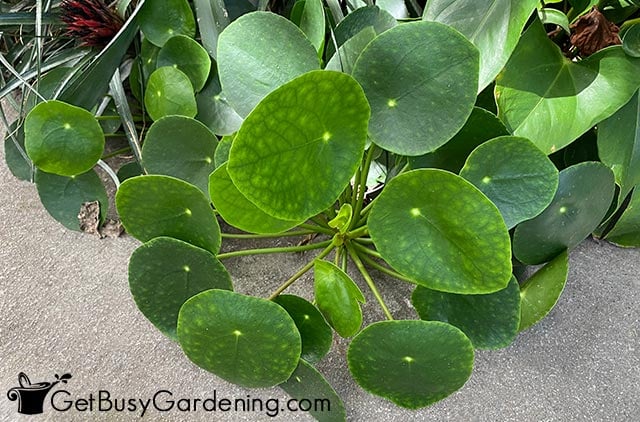
Chinese Money Plant Care & Growing Instructions
Now that you know the best place to grow your Chinese money plant, let’s talk about how to care for it. These tips will help provide exactly what it needs to flourish.
Light
Chinese money plants thrive in moderate to bright indirect light. Direct sun will scorch the delicate leaves, so provide full shade outdoors.
Indoors medium light levels can encourage larger leaves. Brighter settings however can increase leaf production and overall plant size.
It’s a good idea to rotate it once in a while to keep the growth even on all sides.
Water
Pilea peperomioides like to dry out between drinks, but not completely.
Wait until the top 2” of soil have dried, then water deeply. Stop when it comes out of the drainage holes at the bottom of the pot, and discard all of the excess.
Never leave it in standing water or it may develop root rot. If you tend to over do it, a moisture meter can be a really helpful tool.
Humidity
Though they are native to humid areas, Chinese money plants tolerate average household levels very well.
If your home is drier than normal, or you begin to notice brown crispy edges, then you can try increasing the humidity.
Set the pot on a pebble tray with water, mist it weekly, or place a small humidifier nearby.
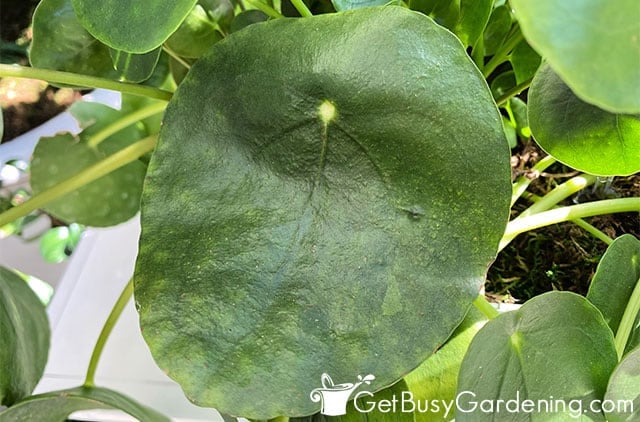
Temperature
The ideal temperature range is between 55-86°F, which is easily maintained indoors.
They can only tolerate cold for a very short period, and will begin to suffer at 50°F or below. High heat is more tolerable, as long as you keep them well watered and out of the direct sun.
Fertilizer
Feeding your Chinese money plant is not necessary, but it’s a great way to stimulate growth and keep it looking its best.
A general or all-purpose houseplant fertilizer is a great option, either as a liquid or using slow-release granules.
Try compost tea or fish emulsion monthly from spring through early fall, or use granules once per season.
Soil
Choosing the right soil is important to for optimal Chinese money plant care. One that holds too much moisture could cause rot, while too little can lead to the leaves drying out.
Select a well-draining, loose potting soil mixture with a few naturally water-retentive materials, like coco coir or vermiculite, as ingredients.
Or make your own by combining 4 parts of good-quality potting soil with 1 part perlite or pumice.

Repotting
A common reason for repotting is to remove the offsets, but Pilea peperomioides plants don’t have large roots and like to be snug in their pots.
Instead of doing it on a set schedule, check for signs that it needs it. Roots coming out of the drainage holes, soil that won’t absorb water, or slowed growth are good indicators.
Wait until spring, and choose a container no more than one pot size larger with good drainage.
Pruning
There’s no real reason to prune your Chinese money plant as a regular part of their care, unless you’re removing dead or damaged leaves.
Those can be snipped off with sharp, sterile snips or precision pruners any time during the year. Cut them at the base where they grow from the main stem.
Pest Control Tips
Healthy Chinese money plants don’t have many issues with pests, but occasionally aphids, whiteflies, or fungus gnats can become a problem.
Treat any that you see right away. Use an organic treatment method, like a neem oil spray or an insecticidal soap, to get rid of them.
You can make your own easily by mixing 1 teaspoon of mild liquid soap with 1 liter of water.
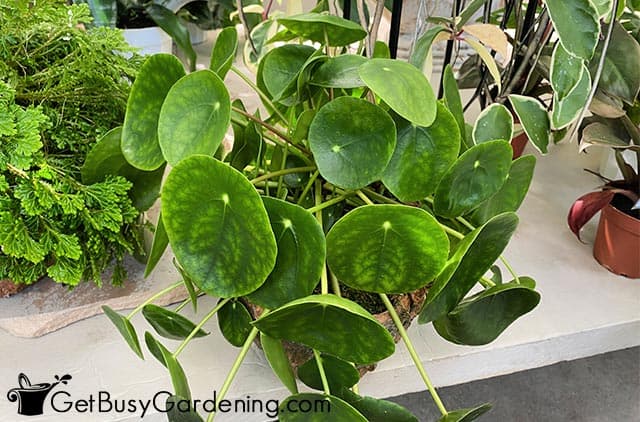
Pilea peperomioides Propagation Tips
It’s possible to propagate Pilea peperomioides from seed, but it’s far more common and easy to do it from cuttings or by division.
Stem cuttings can root in either water or soil, and are best taken in the spring or summer during the plants most active growth.
The offsets can be removed with a sharp, clean snip or precision shears. Keep the roots attached and pot them up in a fast-draining medium.
Troubleshooting Common Problems
Chinese money plants are low maintenance once you know how to care for them. But if you run into one of these common issues, my tips can help you get yours back on track.
Yellow Leaves
Yellowing can occur for a few different reasons. If you’re seeing new leaves turn yellow, it’s likely an issue of overwatering or a nutrient deficiency.
Use a moisture meter to ensure you’re not overdoing it, and try feeding it a houseplant fertilizer.
If older leaves are occasionally yellowing and dropping it’s a normal part of the growth process and nothing to worry about. However if several of them are, try increasing the light exposure.
Leaves Curling
When Pilea peperomioides leaves curl, it can be from many causes.
If they’re rolling under, then it’s possible you’re dealing with lack of or too much light, low nitrogen levels, cold temperatures, or improper watering.
Wait until they dry out 2” deep before watering, but never let the plant get bone-dry. Keep them in bright light, but never direct sun, and in an area that’s warmer than 60°F.
Plant Drooping
Chinese money plant leaves droop most often due to over or under watering, temperature extremes, transplant shock, or lack of light.
Use a moisture meter to help you provide the perfect amount of water. Indoors you can add a grow light or move it to a brighter location. Try to avoid temperatures above the mid-80’s or sudden cold exposure.
Dropping Leaves
If your plant is dropping healthy leaves it’s likely due to abrupt temperature swings.
Keep it away from drafts or heating vents, and try to avoid sudden temperature shifts in its environment.
Older leaves will naturally turn yellow and drop as they age. If you have just the occasional lower leaf falling off, there’s no need to worry.
Brown Spots
Brown spots can be caused by under watering, low humidity, lack of nutrients, bugs, or sunburn.
Keep them out of direct sun, avoid letting them dry out completely for long periods, and increase the humidity level. If browning continues, try adding fertilizer.
FAQs
Here I’ve answered some of the most commonly asked questions about Chinese money plant care. If yours isn’t on the list, please add it to the comments section below.
Where should I put my Chinese money plant?
You can put your Chinese money plant anywhere it will receive bright, indirect light. That can be a shaded spot outdoors, or many indoor locations, especially near a sunny window.
Are Chinese money plants hard to care for?
Chinese money plants are not hard to care for once you understand how to create their ideal environment. Provide plenty of light, water them when the soil dries out, and keep them in a well-draining medium.
How can I make my Chinese money plant grow faster?
You can encourage your Chinese money plant to grow faster by providing lots of bright light and feeding it regularly with an organic fertilizer from spring through early fall.
Where do Chinese money plants grow best?
Chinese money plants grow best in locations with bright, indirect light, average to high humidity, and temperatures between 55°F and 86°F.
Is Chinese money plant pet safe?
Yes, a Chinese money plant is pet safe. It’s considered non-toxic, so it’s safe to grow around cats and dogs.
Now that you understand how to provide the best Chinese money plant care, you can enjoy the unique leaves as part of your collection. These tips can help even beginners grow a Pilea peperomioides successfully.
If you want to learn all there is to know about maintaining healthy indoor plants, then you need my Houseplant Care eBook. It will show you everything you need to know about how to keep every plant in your home thriving. Download your copy now!
More Houseplant Care Guides
- How To Care For Chinese Evergreen (Aglaonema)
- How To Care For Black Pagoda Lipstick Plant
- How To Care For Goldfish Plant (Nematanthus gregarius)
- How To Care For Alocasia Plants
- How To Care For A Philodendron Birkin Plant
- How To Care For Foxtail Fern (Asparagus densiflorus ‘Myers’)
Share your Chinese money plant care tips in the comments section below.
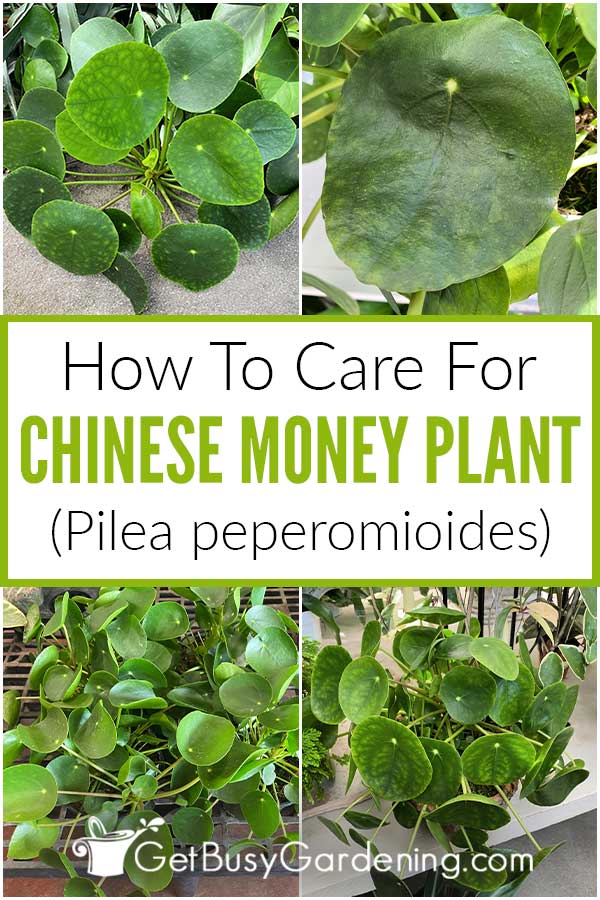
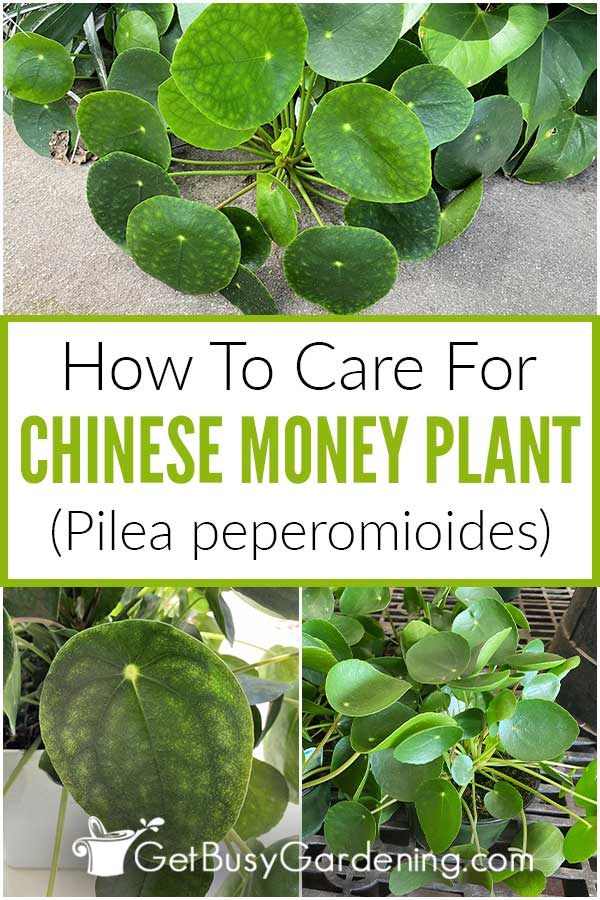
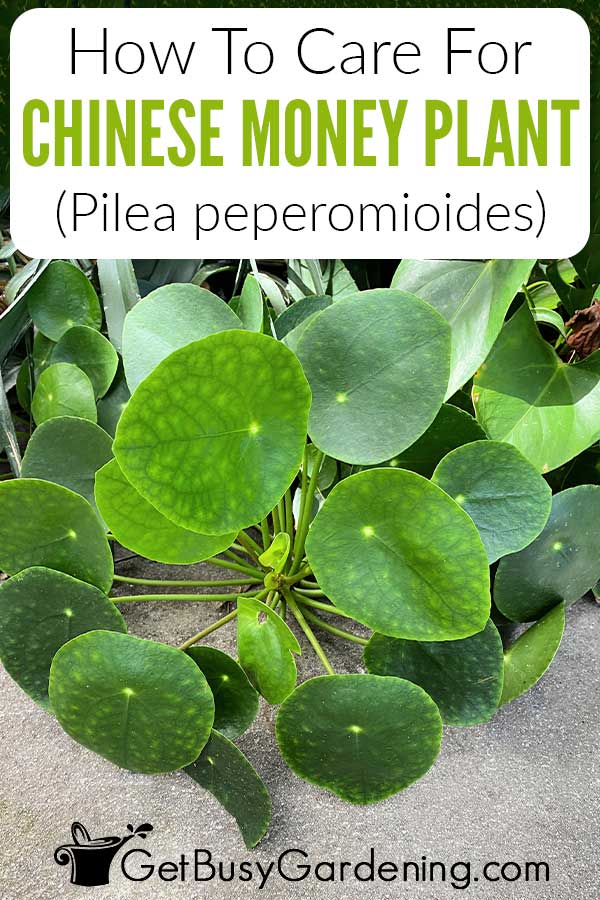



Leave a Reply